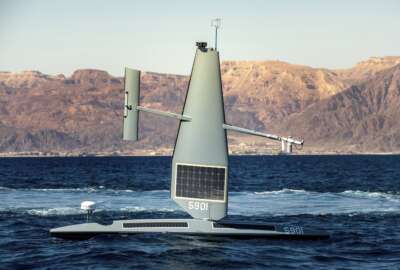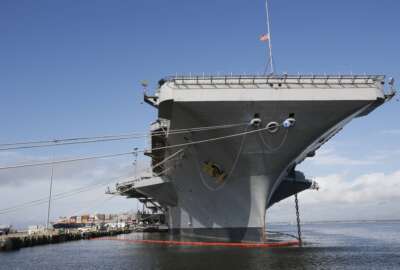The Navy has trouble keeping its amphibious ships in working order
The Navy has problems keeping its fleet of amphibious ships available for both training and operations. Some of the vessels have been out of service for years.
The Navy transports Marines aboard amphibious warfare ships. The Navy also has big problems keeping its fleet of amphibious ships available for both training and operations. Some of the vessels have been out of service for years. Diana Maurer, director of defense capabilities and management issues at the Government Accountability Office, joined the Federal Drive with Tom Temin for more information about what auditors found.
Interview transcript:
Tom Temin: And you looked at a fleet of about 30 of these ships at the direction of Congress. They really want to report in this. This was a statutory requirement report from the NDAA. What’s going on with these seemingly crucial vessels?
Diana Maurer: Well, the Navy for a number of years has had a big problem maintaining the fleet of amphibious ships. So the time we were doing our review with the Navy had and has a fleet of 32 amphibs as they’re called. At the time of our review, half of those ships by the Navy’s own assessment were in poor condition. And that’s a result of a number of problems that have plagued the Navy over the years. Delays in performing maintenance, deferred maintenance, shortages of spare parts, among others. It’s a significant problem for the Navy. And it’s even, frankly, a more significant problem for the Marines because the Marine Corps relies on these amphibious ships to move its Marines around the globe to perform training and execute missions.
Tom Temin: I think there was a movie line where one Marine said to a sailor, ‘Yeah, we’re going to go doing the fighting and you guys are just going to give us a ride there or something.’ This is an example of that.
Diana Maurer: Yeah. There certainly is no shortage of a very healthy and sometimes tongue-in-cheek back-and-forth between the Navy and the Marines. And this is one area where it plays out. But in this case, it really has some significant real life considerations. I mean, one of the things that we found is that the Navy and the Marine Corps had different definitions of the number of ships that they felt that each other needed to perform their mission and different definitions of what was meant for a ship to be available. That sounds wonky, but it really drives a lot of the operational requirements for the Marine Corps in particular.
Tom Temin: And these aren’t landing craft. These are ships that have to go distances with both people and materiel, correct?
Diana Maurer: Correct. These are huge capital ships that can carry hundreds of sailors, hundreds of Marines in some cases. To the untrained eye, they look like little aircraft carriers. So the Marine Corps relies on some classes of these ships to move its aviation around. So these amphibious ships are critical to the Marine Corps ability to deploy and project forces around the globe.
Tom Temin: And are they old and conventionally powered?
Diana Maurer: Many of these ships are old. Many of them are decades old. Some of them are approaching the end or past the end of their expected life. They are conventionally powered. One of the many challenges that we identified in this report and some of our prior reports is that the very age of these ships, combined with how frequently they have been used over the preceding decades, has really compounded the maintenance challenge of the Navy faces to maintain and operate these ships.
Tom Temin: And the fact that Congress commissioned this GAO study means everybody knows what’s going on. They just wanted to kind of quantify and put a exclamation point at the end of it.
Diana Maurer: Exactly. Congress has frankly been very frustrated by the poor condition of the amphibious fleet. They’re also been frustrated by the lack of agreement between the Navy and the Marine Corps on the number of ships, the size of the fleet and the number of ships within that fleet that should be available at any one time. So Congress, a year or two ago said, ‘Look, there needs to be at least 31 amphibious ships in the fleet at all times and Navy and Marine Corps, you need to agree on the number that the subset of that 31 that should be available for missions.’ And so they’re in the process of doing that.
Tom Temin: We’re speaking with Diana Maurer, director of defense capabilities and management issues at the Government Accountability Office. And how did things get to this point? I mean, clearly, it’s a money issue, but it all sounds it also sounds like maybe a management and attention issue.
Diana Maurer: Yeah, it’s been a of a variety of factors. So the Navy and the Marine Corps have heavenly utilized the amphibious fleet going back many decades. This contributes to the ships being in poorer condition when they’re coming in for their planned maintenance than anyone anticipated. So when they come into port for extended periods of maintenance, they’re in worse shape. So maintenance takes longer. That issue is also compounded by problems getting the necessary spare parts for all the complicated systems that are necessary to operate these ships. In some cases, the original manufacturers have gone out of business. So then anybody has to scrounge around to find the parts. In other instances, the parts that current contractors provide are in lousy shape. So that’s a problem. The maintenance takes longer than planned. That’s a problem. When the ships are out at sea and some of our earlier reports, we found that there are not enough sailors aboard these ships to perform the necessary preventive maintenance. This all combines to create a kind of a perfect storm in a very negative sense for performing the necessary maintenance. So maintenance takes longer, it’s not being done and therefore, the availability of these ships has really declined precipitously over the last few years.
Tom Temin: Yeah. They don’t want to use Carnival Cruise Lines if we need to go to war or something like that. And I’m looking at one page of the report, which shows the Navy organizations, I’m reading the title, with primary responsibility for amphibious fleet maintenance. There’s a lot of organizations. I mean, ultimately, of course, it’s the secretary of the Navy. But you have the CNO, you have NAVSEA, Naval Surface Warfare Centers, Fleet Forces, and on and on it goes. That seems like a really tough tangle for anyone to say, ‘I’ll fix this and let me have the resources. ‘
Diana Maurer: That certainly is one of the complicating factors for the Navy in managing the maintenance enterprise for the surface fleet and frankly, for the rest of the fleet as well. There are a lot of different organizations. Many of them are highly specialized, but that we’ve found in some of our other work that the Navy sometimes struggles to bring it all together in a comprehensive and strategic way, simply because there are so many players involved in the maintenance enterprise. So I think that’s one contributing factor. One of the things that we talked about in this report is that over the last dozen years or so, the Navy was made over 70% of the time in performing planned maintenance so that the depot-level maintenance, the most significant maintenance. And these delays contributed to then the Marine Corps losing almost 29 years of available training at an operational time for the amphibious ships that they need to perform their missions. So those are significant shortfalls.
Tom Temin: All right. Then what are your main recommendations? How do they get out of this? Because, again, it’s a complicated organizational piece. Nobody’s planned it correctly. And there’s really no single belly button that seems like that’s responsible.
Diana Maurer: So we had a number of recommendations in this report. One of those was around telling the Navy and the Marine Corps to let’s get to the point where you can honest to goodness reach agreement on the number of amphibious ships that need to be operational available at all times. I mean, the Congress has set out some goals that they’ve put into the NDAA, but the Navy and the Marine Corps are still talking around this issue. At the high level, they’ve reached agreement. But we found that down in the all important weeds, they hadn’t reached agreement on what does it mean for a ship to be available. So we think that’s important. One of the second things we recommended was that the Navy has had a couple of initiatives over the last two years to fix the problems with its amphibious fleet, but they haven’t had time frames or a plan for implementing those recommendations. So we said in this report, ‘OK, let’s Navy, you need to develop the time frames for when you’re going to take the actions to implement the recommendations from your own internal reviews designed to fix the problems as well as come up with the specific number of ships that are required to meet operational responsibilities.’ A third issue that we identified and recommendations around was that a couple of years ago the Navy was canceling planned maintenance because it assumed it was planning to retire some of these ships early. They canceled this maintenance before Congress actually approved retiring those ships early. Congress didn’t go along with that. So then the Navy was stuck with a major problem. So we said, ‘Maybe you need to stop doing this. Don’t actually cancel planned maintenance until Congress approves what your proposed early divestment of ships.’ The Navy agreed and they said they’re going to be taking action to put this into policy.
Tom Temin: Are there any plans anywhere for construction of new ones or is that a pipe dream at this point?
Diana Maurer: So the Navy definitely has plans to construct new ships. Obviously, they have a statutory requirement to maintain a fleet size of at least 31. What we found basically that the Navy’s plans to do this are what we would say optimistic, probably very optimistic. So, for example, for the Navy to meet that 31 goal over into the 2030s, they’re going to have to build these new amphibious ships twice as fast as they currently do. That currently takes about 6 1/2, seven years or so. They say, ‘No, no, no, we’re going to get that down to 3 1/2 years. We don’t see that in terms of our ongoing work. It’s a strategy based on hope. We hope that they get there. The Navy hopes that it gets there, but it’s hope as a strategy and that isn’t necessarily a good path forward.
Tom Temin: And is there a defense industrial base capable of supporting this construction? If they had the funds and had a plan to do so?
Diana Maurer: That’s definitely an open question. A lot of the work that we’ve done over the past several years on new Navy shipbuilding, they’ve been consistently taking longer and spending more across all classes of ships. The defense industrial base on the Navy side, there’s been a lot of attention focused on that. They’re arguably aren’t enough workers, aren’t enough maintainers, aren’t enough facilities to meet the Navy’s future needs for what it plans to do with growing the fleet.
Tom Temin: Whereas Henry Kaiser when you need them.
Copyright © 2025 Federal News Network. All rights reserved. This website is not intended for users located within the European Economic Area.
Tom Temin is host of the Federal Drive and has been providing insight on federal technology and management issues for more than 30 years.
Follow @tteminWFED






